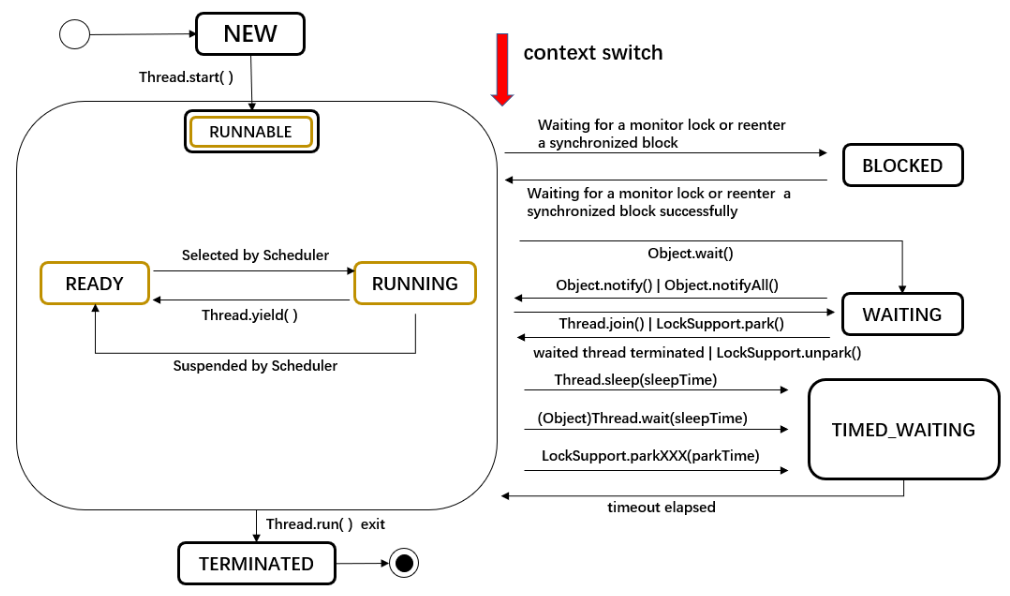一、Java线程生命周期与状态切换

这些状态的描述可以总结成下图:

NEW
一个刚创建但尚未启动的Java线程实例就是处于 NEW 状态
public class App { public static void main(String[] args) { Thread thread = new Thread(); Thread.State state = thread.getState(); System.out.println(state); } } // 输出结果 NEW
RUNNABLE
当Java线程实例调用了 Thread.start() 方法后,就会进入 RUNNABLE 状态,RUNNABLE状态包含两个子状态:READY 和 RUNNING。
- READY:该状态的线程可以被线程调度器进行调度使之更变为RUNNING状态。
- RUNNING:该状态表示线程正在运行,线程对象的run()方法中的代码所对应的的指令正在被CPU执行。
当Java线程实例Thread.yield()方法被调用时或者由于线程调度器的调度,线程实例的状态有可能由RUNNING转变为READY,但是从线程状态Thread.getState()获取到的状态依然是RUNNABLE。例如:
public class App { public static void main(String[] args) { Thread thread = new Thread(()->{ Thread.yield(); System.out.println("testThreadState"); }); thread.start(); Thread.State state = thread.getState(); System.out.println(state); } } // 输出结果 RUNNABLE testThreadState
BLOCKED
阻塞状态,该状态下的线程不会被CPU分配执行时间,线程的状态为 BLOCKED的时候有两种可能的情况:
- 线程正在等待一个监视器锁,只有获取监视器锁之后才能进入synchronized代码块或者synchronized方法,在此等待获取锁的过程线程都处于阻塞状态。
- 线程 X 已步入synchronized代码块或者synchronized方法后,调用Object.wait()方法之后进行阻塞(此时已经释放监视器锁),然后线程 T 获取到该监视器锁,此时,如果线程 X 接收到线程 T 调用该锁对象Object#notify()/notifyAll(),但是线程 T 尚未退出它所在的synchronized代码块或者synchronized方法,那么线程 X 依然处于阻塞状态(注意API注释中的reenter,理解它场景2就豁然开朗)。

public class App { public static void main(String[] args) { App app = new App(); Thread thread1 = new Thread(() -> { app.produce(); }); Thread thread2 = new Thread(() -> { app.consumer(); }); thread1.start(); thread2.start(); System.out.println("thread1:" + thread1.getState()); System.out.println("thread2:" + thread2.getState()); } public void produce() { synchronized (this) { try { Thread.sleep(5000); } catch (InterruptedException e) { e.printStackTrace(); } } } public void consumer() { synchronized (this) { System.out.println("testThread"); } } } // 输出结果 thread1:RUNNABLE thread2:BLOCKED testThread
thread1先运行,拿到 synchronized 锁,执行 produce方法中的 synchronized 代码块中的代码-->等待5秒,这时候 thread2 再运行,状态为 BLOCKED,等到 thread1执行 synchronized代码块结束,thread2 拿到 synchronized 锁,才能执行 consume 方法中的 synchronized 代码块中的代码。

public class App { public static void main(String[] args) throws InterruptedException { App app = new App(); Thread thread1 = new Thread(() -> { app.produce(); }); Thread thread2 = new Thread(() -> { app.consumer(); }); thread1.start(); thread2.start(); // 这里让主线程sleep 1500毫秒从而让thread2调用了notify()并且尚未退出synchronized代码块,确保thread1执行了wait() Thread.sleep(1500); System.out.println("thread1:" + thread1.getState()); System.out.println("thread2:" + thread2.getState()); } public void produce() { synchronized (this) { try { this.wait(); } catch (InterruptedException e) { e.printStackTrace(); } } } public void consumer() { synchronized (this) { try { this.notify(); Thread.sleep(3000); } catch (InterruptedException e) { e.printStackTrace(); } System.out.println("testThread"); } } } // 输出结果 thread1:BLOCKED thread2:TIMED_WAITING testThread
thread1先运行,执行 wait() 方法进入 WAITING状态并释放锁,thread2再执行,执行 notify()方法唤醒 thread1,本来 thread1应该变化为 RUNNABLE状态,但是因为 thread2的synchronized代码块还没执行完,后面还有一个 Thread.sleep(3000)没执行完,thread2还拿着这把锁,所以,thread1就还是BLOCKED阻塞状态。
WAITING
无限期的等待状态,这种状态下的线程不会被CPU分配执行时间。当一个线程执行了某些方法后就会进入 WAITING 状态,被显式唤醒后又变化为 RUNNABLE状态继续执行。
RUNNABLE 转换为 WAITING 的方法:
- Object#wait()
- Thread#join()
- LockSupport.park()
WAITING 转换为 RUNNABLE 的方法:
- Object#notify()或者Object#notifyAll()
- LockSupport.unpark(thread)
public class App { public static void main(String[] args) throws InterruptedException { App app = new App(); Thread thread = new Thread(() -> { app.produce(); }); thread.start(); // 这里让主线程sleep 1500毫秒,确保thread执行了wait() Thread.sleep(1500); System.out.println("thread:" + thread.getState()); } public void produce() { synchronized (this) { try { this.wait(); } catch (InterruptedException e) { e.printStackTrace(); } } } } // 输出结果 thread:WAITING
TIMED_WAITING
有限期等待状态,它和WAITING有点相似,这种状态下的线程不会被分配CPU执行时间,不过这种状态下的线程不需要被显式唤醒,只需要等待超时限期到达就会被唤醒。
RUNNABLE转换为TIMED_WAITING的方法:
- Object#wait(timeout)
- Thread#sleep(timeout)
- Thread#join(timeout)
- LockSupport.parkNanos(timeout)
- LockSupport.parkUntil(timeout)
待超时时间结束,就由TIMED_WAITING状态转换为RUNNABLE状态。
public class App { public static void main(String[] args) throws InterruptedException { App app = new App(); Thread thread = new Thread(() -> { app.produce(); }); thread.start(); // 这里让主线程sleep 50毫秒,确保thread执行了Thread.sleep(3000) Thread.sleep(50); System.out.println("thread:" + thread.getState()); } public void produce() { synchronized (this) { try { Thread.sleep(3000); } catch (InterruptedException e) { e.printStackTrace(); } } } } // 输出结果 thread:TIMED_WAITING
TERMINATED
TERMINATED状态表示线程已经终结。一个线程实例只能被启动一次,准确来说,只会调用一次Thread#run()方法,Thread#run()方法执行结束之后,线程状态就会更变为TERMINATED,意味着线程的生命周期已经结束。
public class App { public static void main(String[] args) throws InterruptedException { App app = new App(); Thread thread = new Thread(() -> { app.produce(); }); thread.start(); // 这里让主线程sleep 50毫秒,确保thread执行了synchronized代码块中的代码 Thread.sleep(50); System.out.println("thread:" + thread.getState()); } public void produce() { synchronized (this) { System.out.println("testThread"); } } } // 输出结果 testThread thread:TERMINATED
